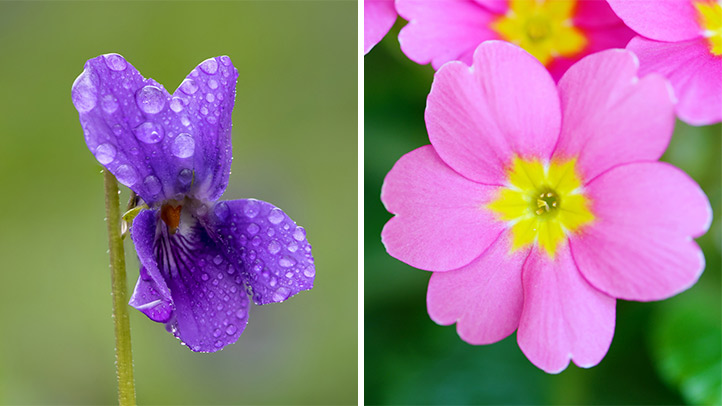The February Birth Flower is the violet, a delicate and charming flower that symbolizes love, loyalty, and modesty. Known for its vibrant hues and subtle fragrance, the violet holds a special place in history, culture, and personal expression. This article explores the origins, meanings, symbolism, and significance of the violet as the February Birth Flower and its unique attributes that make it a treasured choice for birthdays in February.
History of the Violet
Violets have been admired for centuries for their beauty and symbolism. Ancient civilizations, including the Greeks and Romans, associated violets with love and fertility. In Greek mythology, violets were linked to the goddess Aphrodite, the goddess of love, who was often depicted with these delicate flowers. In Rome, violets were used in celebrations, garlands, and even medicinal remedies. The violet’s historical significance has contributed to its lasting symbolism as the February Birth Flower.
During the Middle Ages, violets were cultivated in monastic gardens and used in religious ceremonies. They were also believed to bring protection, good fortune, and peace of mind. Over time, the violet became a symbol of modesty and humility, as it is a flower that blooms low to the ground and often remains understated in gardens, hiding its beauty from immediate view.
Symbolism of the Violet
The violet carries rich symbolism, particularly when recognized as the February Birth Flower. This flower is traditionally associated with love, loyalty, and devotion. Its modest appearance reflects humility and virtue, making it a meaningful gift to express genuine affection without extravagance. In Victorian times, violets were used to convey secret messages of love and admiration, embodying the language of flowers known as floriography.
Additionally, violets are often linked with spiritual wisdom and introspection. Their subtle presence encourages reflection, patience, and appreciation for quiet beauty. The violet’s symbolism extends beyond romantic love, encompassing friendship, trust, and steadfastness. As the February Birth Flower, it serves as a reminder of enduring relationships and sincere connections.
Varieties and Colors of Violets
Violets come in various species and colors, each with its own meaning and appeal. The most common colors include purple, blue, white, and yellow. Purple violets are traditionally associated with loyalty and devotion, while white violets symbolize purity, innocence, and modesty. Blue violets represent faithfulness and calmness, and yellow violets convey joy and happiness.
Gardeners and flower enthusiasts often choose violets for their resilience and ability to thrive in diverse environments. These flowers can bloom in early spring or even in cooler climates, making them a popular choice for February birthdays. Their charming appearance and subtle fragrance further enhance their reputation as the February Birth Flower.
Medicinal and Cultural Significance
Historically, violets have been used in herbal remedies and culinary applications. They are rich in vitamins and antioxidants and have been used to treat respiratory ailments, skin conditions, and digestive issues. Violet leaves and flowers can also be candied or infused into teas, adding both flavor and health benefits.
In cultural contexts, violets have inspired poetry, art, and folklore. Many writers and artists have celebrated the flower’s delicate beauty and symbolic depth. Being the February Birth Flower, violets often appear in birthday bouquets, greeting cards, and decorations to honor loved ones born in February.
Gifting the February Birth Flower
Gifting violets is a thoughtful and meaningful way to express emotions. Their symbolism of love, loyalty, and modesty makes them ideal for close relationships, including family, friends, and romantic partners. A bouquet of violets can convey admiration and appreciation without overwhelming grandeur, staying true to the flower’s understated charm.
For February birthdays, violets serve as a perfect representation of the celebrant’s character and qualities. Including the flower in arrangements, jewelry designs, or personal keepsakes highlights its status as the February Birth Flower and strengthens the connection between the giver and recipient.
Caring for Violets
Violets are relatively easy to care for, making them accessible to both novice and experienced gardeners. They thrive in well-drained soil with moderate sunlight and consistent watering. Regular pruning and deadheading encourage longer blooming periods and healthier growth. Indoor violets, such as African violets, can brighten homes year-round and provide a lasting reminder of the February Birth Flower’s beauty and significance.
In addition, planting violets in a garden or keeping them in pots symbolizes nurturing relationships and personal growth. Their modest yet resilient nature serves as an inspiration for patience, loyalty, and quiet perseverance.
Conclusion
The violet stands as a timeless emblem of love, loyalty, and modesty. Celebrated as the February Birth Flower, it carries a rich history, deep symbolism, and cultural significance that make it more than just a beautiful plant. Whether gifted as a bouquet, cultivated in gardens, or enjoyed for its subtle fragrance, the violet serves as a meaningful tribute to those born in February. Its delicate charm and understated elegance remind us of the value of humility, devotion, and enduring love, embodying the very essence of the February Birth Flower in every petal and hue. By honoring the violet, we celebrate not only the month of February but also the timeless virtues it represents.



